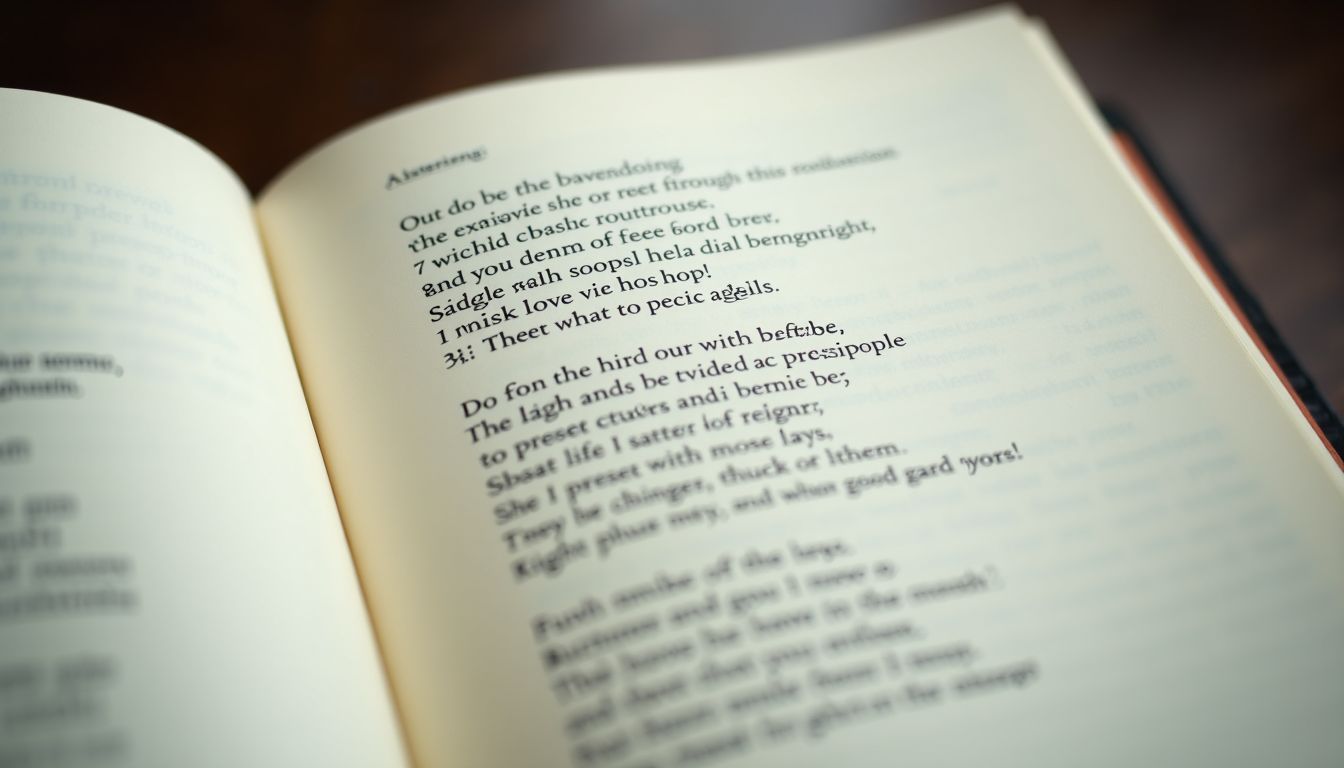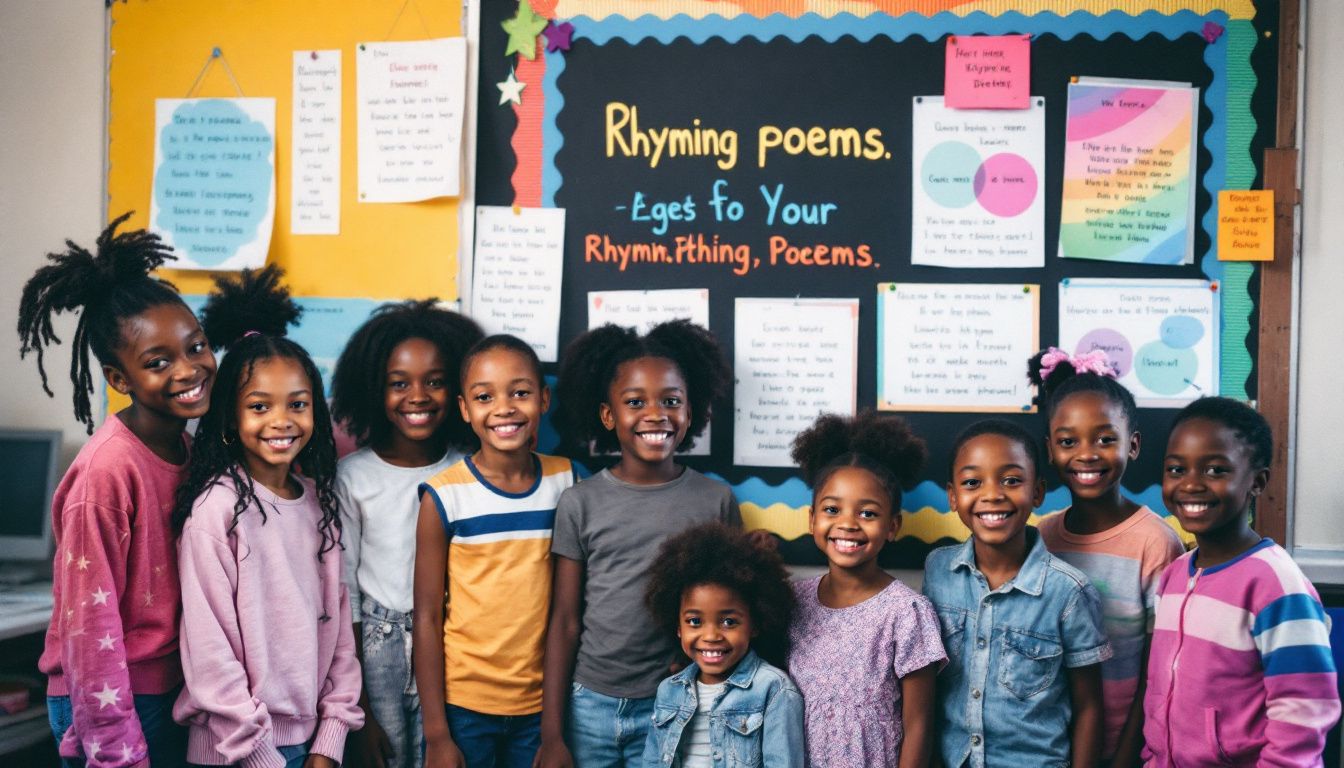Teaching Rhyme Schemes To Kids

Teaching rhyme schemes to little ones can be a bit of a pickle. I’ve been in those shoes and stumbled upon some cracking ways to make it a jolly good time.
This guide offers 4 easy-peasy tips and exercises to help children get their heads around rhyme patterns.
So, get ready for a rhyming adventure that’ll knock your socks off!
Key Takeaways
- Rhyme schemes are patterns of rhymes at the end of poem lines, shown by letters like ABAB.
- Common rhyme schemes include Alternate Rhyme (ABAB), Coupled Rhyme (AA BB CC), and Enclosed Rhyme (ABBA).
- Fun games like Rhyme Bingo, Rhyme Scavenger Hunt, and Rhyme Charades help kids learn rhyme schemes.
- To spot rhyme patterns, look at line endings, count lines in stanzas, and use letters to mark rhymes.
- Writing rhyming lines involves picking a topic, creating a first line, finding rhyming words, and building a pattern.
Table of Contents
What Is a Rhyme Scheme?

Let’s explore rhyme schemes. A rhyme scheme is a pattern of rhymes at the end of each line in a poem.
Poets use letters to show this pattern. For example, lines that rhyme with each other get the same letter.
The poem “The Cow” by Robert Louis Stevenson has an ABAB rhyme scheme. This means the first and third lines rhyme, and the second and fourth lines rhyme.
There are many types of rhyme schemes. Some common ones are Alternate Rhyme (ABAB), Coupled Rhyme (AA BB CC), and Enclosed Rhyme (ABBA).
Poets can use these patterns to create rhythm and structure in their work. Not all poems need to rhyme, though. Free verse and haikus often don’t use rhyme schemes at all.
How To Teach Rhyme Schemes To Kids
Teaching rhyme schemes to kids can be fun and easy. I’ll show you simple ways to explain rhymes and share fun games to help kids learn.
1. Simple explanations with examples
I love to teach rhyme schemes with fun examples. Kids grasp the idea quickly when we use poems they know.
Take “The Cow” by Robert Louis Stevenson. It has an ABAB pattern. This means the first and third lines rhyme, and the second and fourth lines rhyme.
Dr. Seuss books are perfect for showing rhyme schemes. “Green Eggs and Ham” repeats A and B lines.
This makes it easy for kids to spot the rhymes. For older students, I use Shakespeare’s “Sonnet 18”.
It has a complex ABABCDCDEFEFGG scheme. This shows how poets can use rhyme to create structure in their work.
2. Engaging activities and games
Games make learning rhyme schemes fun. Kids love to play while they learn new things.
- Rhyme Bingo: Make bingo cards with words that rhyme. Call out words and have kids mark matching rhymes.
- Rhyme Scavenger Hunt: Hide rhyming words around the room. Kids find and match them.
- Rhyme Charades: Act out words that rhyme. Others guess the rhyming pair.
- Rhyme Memory: Create cards with rhyming pairs. Kids flip cards to find matches.
- Rhyme Hopscotch: Write rhyming words in hopscotch squares. Kids hop and say rhymes.
- Rhyme Relay Race: Teams race to find rhyming words for a given word.
- Rhyme Pictionary: Draw pictures of rhyming words. Others guess the rhyme.
- Rhyme Telephone: Whisper a rhyme down the line. See how it changes.
These games help kids grasp rhyme schemes in a fun way. Now lets look at some exercises for practising rhyme schemes.
Exercises for Practising Rhyme Schemes

I’ve got some fun exercises to help kids learn rhyme schemes. These tasks will make them better at spotting and using rhymes in poems.
3. Identifying rhyme patterns in poems
Rhyme patterns in poems can be fun to spot. Let’s explore some ways to find them.
- Look at the ends of lines. Words that sound alike often show the rhyme pattern.
- Count the lines in each stanza. A four-line stanza is called a quatrain.
- Use letters to mark rhymes. Give each new sound a new letter, like ABAB or AABB.
- Check if the pattern stays the same. Some poems keep one pattern all the way through.
- Find internal rhymes too. Words can rhyme inside a line, not just at the end.
- Read the poem out loud. Hearing the sounds helps spot rhymes more easily.
- Try to guess the next rhyme. This helps you learn common rhyme schemes.
- Notice if some lines don’t rhyme. Not all poems have perfect rhymes all the time.
- Look for near rhymes. Words that almost rhyme can be part of the pattern too.
- Compare different poems. Each poet might use a unique rhyme scheme.
4. Writing their own rhyming lines
Writing rhyming lines can be fun and easy. Here are some simple steps to help children create their own rhymes:
- Pick a topic you like. It could be about your pet, a favourite toy, or even the weather.
- Write a first line about your topic. For example, “My dog loves to play in the park.”
- Think of words that rhyme with the last word of your first line. For “park”, you might think of “bark”, “dark”, or “lark”.
- Use one of these rhyming words to create your second line. It could be, “He runs so fast, I hear him bark.”
- Keep going with more lines. Try to make them fit a pattern like ABAB or AABB.
- Read your lines out loud. This helps you hear if the rhythm sounds good.
- Don’t worry if it’s not perfect. Practice makes better rhymes over time.
- Share your rhymes with friends or family. They might give you ideas to make them even better.
- Try different types of rhymes. You can use full rhymes, half rhymes, or even made-up words.
- Have fun with it! Rhyming is a great way to play with words and express yourself.
Concluding Thoughts on Teaching Rhyme Schemes To Kids

Teaching kids about rhyme schemes can be fun and rewarding. I’ve shared simple ways to explain rhymes and engaging games to play.
The exercises help children spot patterns and write their own rhyming lines.
With these tools, young poets can explore the magic of words and sounds. Rhyme schemes open up a world of creativity for budding writers.
FAQs About Teaching Rhyme Schemes To Kids
1. What is a rhyme scheme in poetry?
A rhyme scheme is the pattern of sounds at the end of lines in a poem. We use letters to show which lines rhyme. For example, ABAB means the first and third lines rhyme, and the second and fourth lines rhyme.
2. How can I teach kids to identify rhyme schemes?
Start with simple poems. Have kids read them out loud. Ask them to find words that sound alike at the end of lines. Then, show them how to use letters to mark the rhymes. Give them lots of practice with different poems.
3. What are some common rhyme schemes for kids to learn?
Common rhyme schemes include couplets (AA), triplets (AAA), and quatrains (ABAB or ABCB). Monorhyme, where all lines end with the same sound, is also fun for kids. Teach these step by step, using clear examples.
4. How does understanding rhyme schemes help with reading comprehension?
Knowing rhyme schemes helps kids grasp the structure of poems. It makes them pay attention to how words sound and connect. This helps them understand the poem’s meaning and tone better. It’s a key part of language arts learning.
5. Can you suggest some exercises to practice rhyme schemes?
Use task cards with short poems. Ask students to mark the rhyme scheme. Have them write their own poems following a given scheme. Read poems aloud and clap when they hear rhymes. Make it a game to spot different rhyming patterns in songs or nursery rhymes.
6. Are there famous poems with clear rhyme schemes for kids?
Yes! “Shall I Compare Thee” by Shakespeare has an ABAB CDCD EFEF GG scheme. “The Tyger” by William Blake uses AABB throughout. Kenn Nesbitt’s Poetry4Kids.com has many kid-friendly rhyming poems. These can help students learn about regular rhyme patterns in entire poems.
References:
- Emily Ague, Administrator and Yasuko Mitsuoka Grow, Designer. (n.d.). The Cow (Robert Louis Stevenson) | Oklahoma Agriculture in the Classroom. https://oklahoma.agclassroom.org/resources_food/songs/cow/
- https://study.com/academy/lesson/poems-with-abab-rhyme-scheme-examples-lesson-quiz.html
- Wikipedia contributors. (2024a, November 4). All things bright and beautiful. Wikipedia. https://en.wikipedia.org/wiki/All_Things_Bright_and_Beautiful
- Books – Seussville. (2020, June 10). Seussville. https://www.seussville.com/books/
- Sonnet 18: Shall I compare thee to a summer’s day? (2024, August 12). The Poetry Foundation. https://www.poetryfoundation.org/poems/45087/sonnet-18-shall-i-compare-thee-to-a-summers-day
- Emily Ague, Administrator and Yasuko Mitsuoka Grow, Designer. (n.d.). The Cow (Robert Louis Stevenson) | Oklahoma Agriculture in the Classroom. https://oklahoma.agclassroom.org/resources_food/songs/cow/
- https://www.site.uottawa.ca/~lucia/courses/2131-02/A2/trythemsource.txt



